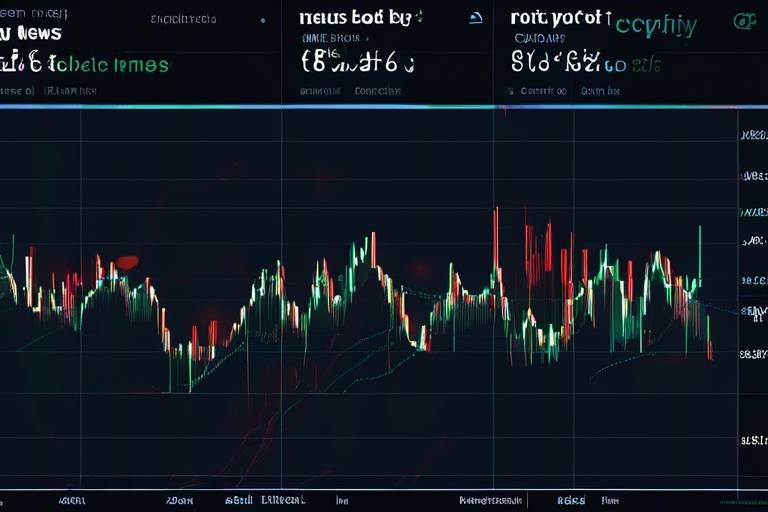The Correlation Between Crypto and Traditional Markets - A Deep Dive
In recent years, the financial landscape has undergone a seismic shift, with cryptocurrencies emerging as a formidable player alongside traditional markets. This evolution has sparked curiosity and concern among investors and traders alike. How do these two seemingly disparate worlds interact? Are cryptocurrencies merely a speculative bubble, or do they hold genuine value that could reshape the global economy? In this article, we will explore the intricate web of relationships between cryptocurrencies and traditional financial markets, examining their interactions, influences, and implications for those navigating this rapidly evolving economic landscape.
The journey of cryptocurrencies began with the launch of Bitcoin in 2009, a revolutionary digital currency that promised decentralization and autonomy from traditional banking systems. Initially, cryptocurrencies were viewed as niche assets, attracting tech enthusiasts and early adopters. However, as the years progressed, their popularity surged, capturing the attention of institutional investors and mainstream financial institutions. Today, cryptocurrencies are not just a passing fad; they have become legitimate financial instruments that influence the global economy.
With the rise of altcoins and blockchain technology, the cryptocurrency market has expanded exponentially. The market capitalization of cryptocurrencies has reached hundreds of billions, and their adoption is becoming more widespread, with companies like Tesla and Square investing heavily in Bitcoin. This growing influence has led to a fascinating dynamic where cryptocurrencies are increasingly intertwined with traditional financial markets, creating a complex correlation that investors must understand.
Understanding market correlation is essential for any investor looking to navigate the financial landscape effectively. In simple terms, correlation refers to the relationship between two assets and how they move in relation to one another. A positive correlation means that when one asset increases in value, the other tends to do the same. Conversely, a negative correlation indicates that when one asset rises, the other falls.
When it comes to the relationship between cryptocurrencies and traditional markets, the correlation can be both surprising and explosive. For instance, during times of economic uncertainty, many investors flock to safe-haven assets like gold, which can impact the demand for cryptocurrencies as an alternative store of value. Understanding these dynamics is crucial for developing effective investment strategies.
One of the most intriguing aspects of the correlation between crypto and traditional markets is the relationship between cryptocurrencies and stocks. As more institutional investors enter the crypto space, the movements in one market can significantly impact the other. For example, a downturn in the stock market might lead some investors to seek refuge in cryptocurrencies, while a rally in stocks could draw attention away from digital assets.
When comparing the volatility of cryptocurrencies to traditional stocks, the difference is stark. Cryptocurrencies are notorious for their price fluctuations, often experiencing swings of 10% or more within a single day. In contrast, traditional stocks tend to have more stable price movements. This high volatility in crypto can lead to heightened investor anxiety and a rush to either buy or sell, depending on market sentiment.
Market sentiment plays a critical role in influencing cryptocurrency prices. Events in traditional finance, such as interest rate changes or economic reports, can ripple through the crypto market. For instance, when the Federal Reserve announces a rate hike, it can lead to a sell-off in stocks, which might simultaneously affect the crypto market as investors reassess their risk appetite.
Another fascinating correlation exists between cryptocurrencies and commodities like gold and oil. During periods of economic uncertainty, both gold and Bitcoin are often viewed as safe-haven assets. Investors may flock to these commodities as a hedge against inflation or market downturns, creating a complex interplay between the two asset classes. Understanding this relationship can provide valuable insights for investors looking to diversify their portfolios.
Several factors can influence the correlation between cryptocurrencies and traditional markets. Key among these are economic indicators, regulatory changes, and technological advancements. Each of these elements can either strengthen or weaken the relationship between the two markets.
The regulatory landscape surrounding cryptocurrencies is continually evolving. Government regulations can have significant impacts on both markets. For example, when a country announces stricter regulations on cryptocurrencies, it can lead to panic selling, affecting not only digital assets but also traditional stocks, particularly those of companies involved in the crypto space. Keeping an eye on regulatory developments is crucial for investors in both markets.
Technological advancements are bridging the gap between crypto and traditional markets. Innovations such as blockchain technology are enhancing market efficiency and accessibility, allowing for smoother transactions and greater transparency. As technology continues to evolve, it will undoubtedly influence how these markets interact and correlate.
Given the intricate relationship between cryptocurrencies and traditional assets, developing effective investment strategies is essential. Understanding correlation can help investors make informed decisions about asset allocation and risk management.
Diversifying across both crypto and traditional markets can mitigate risks and enhance portfolio performance. By spreading investments across different asset classes, investors can protect themselves from volatility in any single market. For example, a well-balanced portfolio may include a mix of stocks, bonds, and cryptocurrencies, allowing for exposure to different economic conditions.
Implementing robust risk management strategies is vital for investors involved in both markets. Understanding the dynamics of correlation can help investors minimize potential losses. Techniques such as setting stop-loss orders, regularly rebalancing portfolios, and staying informed about market trends can enhance an investor's ability to navigate the complexities of these intertwined markets.
- What is the primary correlation between cryptocurrencies and traditional markets? The primary correlation lies in how movements in one market can influence the other, particularly during times of economic uncertainty.
- Are cryptocurrencies considered a safe investment? Cryptocurrencies are highly volatile and can be risky; therefore, they should be approached with caution and as part of a diversified portfolio.
- How do regulations affect cryptocurrency prices? Regulatory changes can lead to significant fluctuations in cryptocurrency prices, impacting investor sentiment and market dynamics.

The Rise of Cryptocurrencies
The world of finance has undergone a seismic shift over the past decade, and at the epicenter of this transformation is the rise of cryptocurrencies. Initially dismissed as a passing fad, digital currencies like Bitcoin and Ethereum have evolved from niche assets into formidable players on the global economic stage. But how did we get here? What sparked this meteoric rise, and why should investors pay attention? Let’s dive into the fascinating journey of cryptocurrencies.
The inception of Bitcoin in 2009 marked the beginning of a new era in finance. Created by an anonymous figure or group known as Satoshi Nakamoto, Bitcoin was designed as a decentralized alternative to traditional currencies, free from the control of governments and banks. Its underlying technology, blockchain, promised transparency and security, capturing the imagination of tech enthusiasts and financial rebels alike. This innovative approach to currency laid the groundwork for a plethora of other cryptocurrencies that followed, each with unique features and purposes.
As the years rolled on, the cryptocurrency market began to gain momentum. By 2013, Bitcoin had surpassed the $1,000 mark, signaling to the world that digital currencies were here to stay. This surge in value attracted not only individual investors but also institutional players, further legitimizing the crypto space. Fast forward to today, and the market is awash with thousands of cryptocurrencies, each vying for attention and investment. According to recent data, the total market capitalization of cryptocurrencies has soared to over $2 trillion, illustrating just how far this asset class has come.
But the rise of cryptocurrencies is not just about numbers; it’s about a cultural shift. The appeal of decentralization resonates with a generation disillusioned by traditional financial institutions. Many see cryptocurrencies as a means to regain control over their finances, free from the constraints of banks and government policies. This sentiment has fueled a passionate community of advocates who champion the benefits of digital currencies, from lower transaction fees to increased privacy and security.
However, it’s essential to acknowledge that the journey hasn’t been smooth sailing. The volatility of cryptocurrencies has raised eyebrows and concerns among potential investors. Prices can swing wildly in a matter of hours, creating both opportunities and risks. For instance, Bitcoin reached an all-time high of nearly $65,000 in April 2021, only to plummet below $30,000 a few months later. Such dramatic fluctuations can be daunting, but they also highlight the potential for significant returns, attracting risk-tolerant investors.
As cryptocurrencies continue to gain traction, we see them increasingly integrated into mainstream finance. Major companies are now accepting Bitcoin as a form of payment, and financial institutions are developing crypto-related products. This growing acceptance is a clear indicator that cryptocurrencies are not just a passing trend; they are becoming an integral part of the financial landscape.
In summary, the rise of cryptocurrencies has been nothing short of revolutionary. From their humble beginnings to their current status as a multi-trillion-dollar market, digital currencies have reshaped our understanding of money and investment. As we look ahead, the question remains: how will cryptocurrencies continue to evolve, and what role will they play in the future of finance? Only time will tell, but one thing is certain: the era of digital currencies is just beginning.

The Nature of Market Correlation
Understanding market correlation is crucial for any investor looking to navigate the complex waters of finance. At its core, correlation refers to the statistical relationship between two or more assets, indicating how they move in relation to one another. In the world of finance, this concept can reveal insights into how different markets influence each other. For instance, if cryptocurrencies and traditional stocks are positively correlated, it suggests that when one market rises, the other is likely to rise as well. Conversely, a negative correlation indicates that when one market moves up, the other tends to move down.
In recent years, the relationship between cryptocurrencies and traditional markets has become a hot topic. Many investors wonder if they should treat cryptocurrencies as a separate entity or as an extension of the traditional financial landscape. Understanding the nuances of this correlation can be the difference between a successful investment strategy and a costly mistake. For example, during market downturns, both cryptocurrencies and stocks may experience declines, leading to a phenomenon known as market contagion. This is when negative sentiments in one market spill over into another, causing widespread panic.
To illustrate the correlation between these markets, consider the following table that showcases the correlation coefficients between Bitcoin and major stock indices over the past year:
| Stock Index | Correlation Coefficient (1 Year) |
|---|---|
| S&P 500 | 0.65 |
| NASDAQ | 0.70 |
| DOW JONES | 0.50 |
This table indicates a strong positive correlation between Bitcoin and the NASDAQ, suggesting that movements in tech stocks can significantly impact Bitcoin prices. However, it’s essential to note that correlation does not imply causation. Just because two markets move together does not mean one is causing the other to move. It’s more like a dance; sometimes they lead, and sometimes they follow.
Moreover, market sentiment plays a pivotal role in shaping these correlations. Events such as economic reports, geopolitical tensions, or even social media trends can sway investor sentiment and, in turn, influence the price movements of both cryptocurrencies and traditional assets. For example, when a major tech company reports impressive earnings, it can boost the stock market and simultaneously lift the prices of cryptocurrencies, as investors feel more optimistic about the overall economic landscape.
In summary, understanding the nature of market correlation between cryptocurrencies and traditional financial markets is vital for investors. It allows them to make informed decisions based on how these assets interact. By keeping an eye on correlation dynamics, investors can better anticipate market movements and adjust their strategies accordingly. As we delve deeper into the interconnectedness of these markets, the implications for investment strategies become increasingly clear.
- What is market correlation? Market correlation is a statistical measure that indicates how two or more assets move in relation to each other.
- Why is understanding correlation important for investors? It helps investors make informed decisions and anticipate market movements, potentially leading to better investment strategies.
- Can correlation change over time? Yes, market correlations can fluctuate based on various factors, including economic conditions, investor sentiment, and market events.

The relationship between cryptocurrencies and traditional stocks is a fascinating subject that has piqued the interest of investors and analysts alike. As these two asset classes have evolved, they have begun to exhibit unique behaviors that can significantly impact investment strategies. So, how do these markets interact? Let's dive into the nuances of their relationship and what it means for those looking to invest in either or both.
First off, it’s essential to understand that while cryptocurrencies like Bitcoin and Ethereum have emerged as viable investment options, they are still relatively young compared to the stock market. Stocks have been around for centuries, representing ownership in companies and reflecting their performance. In contrast, cryptocurrencies are decentralized digital assets, relying on blockchain technology and often driven by sentiment and speculation rather than traditional financial metrics.
One of the most notable aspects of the crypto-stock relationship is their correlation. At times, these markets move in tandem, while at other moments, they diverge dramatically. For instance, during periods of economic uncertainty, both markets may react similarly as investors seek safe havens or panic sell. However, the volatility inherent in cryptocurrencies often leads to more extreme price movements, which can amplify the effects on traditional stocks. To illustrate this, consider the following table:
| Market Event | Bitcoin Price Movement | Stock Market Reaction |
|---|---|---|
| COVID-19 Pandemic | -30% | -20% |
| Inflation Fears | +50% | -10% |
| Regulatory News | -15% | -5% |
This table highlights how Bitcoin's price movements can sometimes overshadow those of traditional stocks, showcasing its volatility. Investors often look at these fluctuations to gauge market sentiment. When Bitcoin surges, it can create a ripple effect, encouraging investors to jump into the stock market, particularly tech stocks that are often seen as more innovative and aligned with the crypto ethos.
Moreover, the psychological aspect cannot be overlooked. When stock markets are bullish, retail investors may feel more confident to explore cryptocurrencies, viewing them as an opportunity for higher returns. Conversely, in bearish markets, cryptocurrencies might be viewed as a riskier asset, leading to increased selling pressure. This dynamic creates a fascinating interplay between the two markets, where news and events in one can significantly influence the other.
But it’s not all doom and gloom. Understanding this correlation can lead to more informed investment decisions. For instance, savvy investors might use the volatility of cryptocurrencies to hedge against downturns in the stock market. By strategically allocating a portion of their portfolio to crypto, they can potentially offset losses in traditional equities during turbulent times.
In conclusion, the relationship between cryptocurrencies and stocks is complex and ever-evolving. While they can influence each other, it's crucial for investors to conduct thorough research and remain vigilant about market trends. By staying informed and understanding the nuances of both markets, investors can better navigate the exciting yet unpredictable landscape of modern finance.
- What is the main difference between cryptocurrencies and stocks? Cryptocurrencies are digital assets that rely on blockchain technology, while stocks represent ownership in a company.
- How does market sentiment affect cryptocurrencies? Market sentiment can drive price movements in cryptocurrencies, often leading to higher volatility compared to traditional stocks.
- Can investing in cryptocurrencies help diversify my portfolio? Yes, adding cryptocurrencies to your investment portfolio can provide diversification, but it also comes with higher risks.

When we talk about volatility, we're diving into the wild world of price fluctuations that can make or break an investor's day. Cryptocurrencies are notorious for their extreme volatility, often swinging by double-digit percentages within a single day. For instance, Bitcoin, the leading cryptocurrency, has experienced price movements that can leave even seasoned traders gasping for breath. In contrast, traditional stocks typically exhibit more stable price movements, though they too can experience volatility, especially during earnings reports or economic shifts.
To illustrate this difference, let’s take a look at a comparative table showing the average daily volatility of selected cryptocurrencies versus traditional stocks over a specific period:
| Asset Class | Average Daily Volatility (%) |
|---|---|
| Bitcoin (BTC) | 4.5% |
| Ethereum (ETH) | 5.2% |
| Apple Inc. (AAPL) | 1.2% |
| Amazon.com Inc. (AMZN) | 1.5% |
This table clearly shows that while cryptocurrencies like Bitcoin and Ethereum can fluctuate wildly, traditional stocks like Apple and Amazon tend to have much lower average daily volatility. This difference is crucial for investors to understand because it directly impacts their risk tolerance and investment strategies.
Why does this volatility matter? Well, for traders looking to capitalize on short-term price movements, the high volatility of cryptocurrencies can be a double-edged sword. On one hand, it presents opportunities for significant profits; on the other, it can lead to substantial losses if the market turns against them. In contrast, investors in traditional stocks may find themselves in a more stable environment, but they also miss out on the explosive growth potential that crypto can offer.
Another factor to consider is how market sentiment can amplify these volatility differences. For example, good news in the crypto world can send prices soaring, while bad news can lead to rapid sell-offs. In traditional markets, while sentiment does play a role, the effects are often tempered by established market structures and regulations.
Ultimately, understanding the volatility of both asset classes is essential for constructing a well-rounded investment portfolio. By recognizing the unique characteristics of cryptocurrencies and traditional stocks, investors can make informed decisions that align with their financial goals and risk appetite.
- What is volatility in financial markets? Volatility refers to the degree of variation in trading prices over time, indicating how much an asset's price can change.
- Why are cryptocurrencies more volatile than stocks? Cryptocurrencies are less regulated, have smaller market sizes, and are influenced by speculative trading, leading to larger price swings.
- How can I manage risk in a volatile market? Diversification, setting stop-loss orders, and maintaining a balanced portfolio can help mitigate risks associated with volatility.

The relationship between market sentiment in traditional finance and cryptocurrency prices is a fascinating and complex one. Market sentiment, which refers to the overall attitude of investors toward a particular market or asset, can significantly influence price movements in both sectors. When traditional markets experience bullish trends, it often leads to increased confidence among investors, prompting them to explore alternative investments like cryptocurrencies. Conversely, during bearish trends, fear and uncertainty can spill over into the crypto space, leading to sharp declines in prices.
For instance, consider a scenario where a major stock index, such as the S&P 500, experiences a significant drop due to disappointing economic data. This negative sentiment can trigger a ripple effect, causing investors to panic and sell off their crypto holdings as well, even if the fundamentals of the cryptocurrency market remain strong. The interconnectedness of these markets illustrates how sentiment can act as a double-edged sword, amplifying both gains and losses.
Moreover, specific events in the traditional financial world can have profound implications for cryptocurrencies. Take, for example, announcements from central banks regarding interest rate changes or economic stimulus measures. Such news can sway market sentiment dramatically. A rate cut might encourage investors to seek higher returns in riskier assets, including cryptocurrencies, pushing prices upward. In contrast, an unexpected rate hike could lead to a sell-off in both traditional and crypto markets as investors flock to safer havens.
To illustrate this relationship further, let's look at some key events that have historically influenced market sentiment:
- The COVID-19 Pandemic: The onset of the pandemic led to massive sell-offs in traditional markets, which in turn triggered a surge in interest for cryptocurrencies as investors sought alternative stores of value.
- Regulatory Announcements: News of regulatory crackdowns can create panic in the crypto markets, leading to declines in prices as traders react to perceived risks.
- Technological Breakthroughs: Positive news regarding blockchain technology or major partnerships can uplift sentiment in both sectors, leading to increased investments.
In essence, understanding market sentiment is crucial for anyone looking to navigate the intricate dance between cryptocurrencies and traditional assets. By staying attuned to the mood of the market, investors can better position themselves to capitalize on opportunities and mitigate risks. It’s not just about numbers; it’s about the psychology of the market and how emotions can drive decisions. Therefore, keeping an eye on both traditional market trends and crypto developments can provide valuable insights into potential price movements.
1. How does market sentiment affect cryptocurrency prices?
Market sentiment can influence cryptocurrency prices by creating waves of buying or selling pressure. Positive sentiment may lead to increased investments in cryptocurrencies, while negative sentiment can trigger sell-offs.
2. Are cryptocurrencies more volatile than traditional stocks?
Yes, cryptocurrencies are generally more volatile than traditional stocks. This volatility can be exacerbated by market sentiment, as emotional reactions often lead to rapid price changes.
3. How can investors gauge market sentiment?
Investors can gauge market sentiment through various indicators, including social media trends, news headlines, and market analysis reports. Sentiment analysis tools can also provide insights into how investors are feeling about specific assets.
4. What role do major news events play in market sentiment?
Major news events, such as regulatory announcements, economic reports, or technological advancements, can significantly impact market sentiment, leading to swift changes in investment behavior and asset prices.

The relationship between cryptocurrencies and commodities is a fascinating aspect of the financial landscape that often goes unnoticed. While many investors focus on stocks and bonds, the interaction between digital currencies and traditional commodities like gold and oil can offer valuable insights. To understand this connection, we must first recognize that both asset classes serve as investment vehicles, albeit with differing characteristics and purposes. Cryptocurrencies, often viewed as the new frontier of finance, have emerged as a potential hedge against inflation, much like gold, which has been a safe haven for centuries.
During periods of economic uncertainty, the correlation between cryptocurrencies and commodities can become particularly pronounced. For instance, when geopolitical tensions rise or inflation rates soar, investors tend to flock to commodities like gold, driving up its price. Interestingly, this behavior can also extend to cryptocurrencies, as they are increasingly perceived as a store of value. This duality creates a dynamic interplay where movements in one market can influence the other. For example, if gold prices surge due to heightened inflation fears, we might see a corresponding uptick in Bitcoin prices as investors seek alternative assets.
To illustrate this relationship, consider the following table that highlights key events and their impact on both markets:
| Event | Gold Price Movement | Bitcoin Price Movement |
|---|---|---|
| COVID-19 Pandemic (2020) | ↑ | ↑ |
| Geopolitical Tensions (2021) | ↑ | ↑ |
| Regulatory Crackdowns (2022) | ↓ | ↓ |
This table highlights how significant global events can lead to synchronized movements in both gold and Bitcoin prices, showcasing their evolving relationship. However, it's essential to note that while there may be periods of correlation, the nature of these assets remains distinct. Commodities like gold are tangible and have intrinsic value, while cryptocurrencies are digital and often driven by speculative trading, technology adoption, and market sentiment.
Additionally, the correlation between cryptocurrencies and oil can also be noteworthy. As oil prices fluctuate due to supply chain issues or changes in demand, the broader market sentiment can affect cryptocurrencies. For instance, rising oil prices can signal inflationary pressures, which might lead investors to seek refuge in both gold and Bitcoin. This behavior illustrates how interconnected these markets can be, especially in times of economic turbulence.
In conclusion, the relationship between cryptocurrencies and commodities is complex and multifaceted. As digital currencies continue to gain traction and acceptance, understanding how they interact with traditional commodities will be crucial for investors looking to diversify their portfolios and navigate the ever-evolving economic landscape. By keeping an eye on these correlations, investors can make more informed decisions and potentially capitalize on market movements.
- What is the main difference between cryptocurrencies and commodities?
Cryptocurrencies are digital assets that rely on blockchain technology, while commodities are physical goods that are traded on exchanges, such as gold, oil, and agricultural products.
- Can cryptocurrencies be considered a safe haven like gold?
While cryptocurrencies are increasingly viewed as a hedge against inflation, they are still highly volatile and speculative, making them less stable than traditional safe havens like gold.
- How do geopolitical events affect crypto and commodity prices?
Geopolitical events can lead to increased uncertainty in the markets, prompting investors to seek safe-haven assets. This often results in price surges for both commodities like gold and cryptocurrencies like Bitcoin.

Understanding the factors that influence the correlation between cryptocurrencies and traditional markets is crucial for any investor looking to navigate this complex landscape. The relationship between these two asset classes is not static; it evolves based on a myriad of elements that can either enhance or diminish their interdependence. So, what are these factors? Let's break them down.
First and foremost, economic indicators play a significant role in shaping market dynamics. Indicators such as inflation rates, unemployment figures, and GDP growth can influence investor sentiment across both markets. For instance, during a period of economic growth, traditional stocks may flourish, which can lead to increased investment in riskier assets like cryptocurrencies. Conversely, during economic downturns, investors often flee to safer havens, which can cause a dip in crypto prices.
Another critical factor is the regulatory environment. Government policies and regulations can create ripples across both markets. For example, when a country announces strict regulations on cryptocurrencies, it can lead to a decrease in crypto prices, which might also affect traditional stocks, especially those of companies involved in the blockchain space. The impact of regulations can be profound, as seen in various instances where news of regulatory crackdowns has sent shockwaves through the crypto market, subsequently affecting investor confidence in traditional markets as well.
Technological advancements are also a key player in influencing correlation. The rise of blockchain technology has not only given birth to cryptocurrencies but has also transformed traditional finance. Innovations such as decentralized finance (DeFi) and non-fungible tokens (NFTs) are bridging the gap between the two worlds. As technology continues to evolve, it enhances market efficiency and accessibility, which can lead to a tighter correlation between crypto and traditional assets.
Furthermore, market sentiment is a powerful influencer. Investor emotions can drive market movements in both sectors. For instance, a bullish sentiment in the stock market can spill over into the crypto market, leading to increased investment in digital currencies. Conversely, negative news or market crashes can trigger panic selling in both markets. Understanding these emotional triggers can be vital for investors looking to capitalize on market movements.
Finally, global events such as geopolitical tensions, pandemics, or financial crises can create a domino effect on both markets. These events often lead to uncertainty, prompting investors to reassess their portfolios. The interaction between crypto and traditional markets during such times can be unpredictable, making it essential for investors to stay informed and agile.
In summary, the correlation between cryptocurrencies and traditional markets is influenced by a complex interplay of factors, including economic indicators, regulatory changes, technological advancements, market sentiment, and global events. Being aware of these factors can provide investors with a better understanding of how to position themselves strategically in this rapidly evolving economic landscape.
- What are economic indicators? Economic indicators are statistics that provide information about the economic performance of a country, such as GDP, unemployment rates, and inflation.
- How does regulation affect cryptocurrency prices? Regulatory announcements can significantly impact cryptocurrency prices by influencing investor confidence and market dynamics.
- What role does technology play in the correlation between markets? Technological innovations enhance market efficiency and accessibility, leading to a closer relationship between cryptocurrencies and traditional assets.
- How can global events impact both markets? Global events can create uncertainty, prompting investors to reassess their portfolios and potentially affecting prices in both cryptocurrencies and traditional stocks.

The regulatory environment surrounding cryptocurrencies is one of the most dynamic and complex aspects of the financial landscape today. As digital assets have gained traction, governments and regulatory bodies worldwide have scrambled to catch up, creating a patchwork of regulations that can vary significantly from one jurisdiction to another. This inconsistency can lead to confusion for investors and traders alike, making it crucial to stay informed about the latest developments. In essence, the regulatory framework acts as both a shield and a sword—it can protect investors from fraud and manipulation, but it can also stifle innovation and limit market access.
One of the key challenges in regulating cryptocurrencies is their decentralized nature. Unlike traditional financial instruments, which are often governed by centralized entities, cryptocurrencies operate on blockchain technology, allowing for peer-to-peer transactions without intermediaries. This fundamental difference complicates the regulatory approach, as authorities struggle to determine how to classify these assets. Are they currencies, commodities, or something entirely new? The answer to this question has significant implications for taxation, trading, and investment strategies.
Let's take a look at some of the major regulatory developments that have shaped the landscape:
| Year | Regulatory Development | Impact |
|---|---|---|
| 2014 | IRS classifies Bitcoin as property | Tax implications for transactions |
| 2017 | SEC cracks down on ICOs | Increased scrutiny on fundraising |
| 2020 | EU proposes MiCA regulation | Standardization across member states |
| 2021 | China bans crypto mining | Market volatility and shifts in mining |
These developments illustrate how regulatory actions can significantly influence the market dynamics of cryptocurrencies. For instance, when the U.S. Securities and Exchange Commission (SEC) began scrutinizing initial coin offerings (ICOs) in 2017, it sent shockwaves through the industry, leading to a dramatic decline in new projects. On the flip side, the proposed Markets in Crypto-Assets (MiCA) regulation by the European Union aims to create a more stable and predictable environment for crypto businesses, which could foster growth and innovation.
Moreover, the regulatory environment is not static; it evolves in response to market trends and technological advancements. As new challenges arise—such as concerns about money laundering, fraud, and consumer protection—regulators must adapt their frameworks to address these issues. For investors, this means staying abreast of changes and understanding how they can impact their portfolios. The relationship between regulatory actions and market sentiment is profound; positive news can lead to price surges, while negative developments can trigger sell-offs.
In conclusion, the regulatory environment surrounding cryptocurrencies is a double-edged sword. While it can provide necessary protections and foster legitimacy, it can also impose restrictions that stifle innovation. For investors and traders, navigating this landscape requires vigilance, adaptability, and a keen understanding of how regulations can impact market dynamics.
- What is the main purpose of cryptocurrency regulations?
Cryptocurrency regulations aim to protect investors, prevent fraud, and ensure the integrity of the financial system. - How can regulatory changes affect cryptocurrency prices?
Regulatory news can lead to significant market reactions, with positive regulations often boosting prices and negative ones causing declines. - Are all cryptocurrencies subject to the same regulations?
No, regulations can vary widely by country and even by state or region, leading to a complex legal landscape.

In today's rapidly evolving financial landscape, technology plays a pivotal role in shaping the relationship between cryptocurrencies and traditional markets. As we delve into the realm of technological innovations, it becomes evident that advancements in technology are not just enhancing the efficiency of transactions but are also bridging the gap between these two distinct financial worlds. Imagine the blockchain as a digital highway, where cryptocurrencies zip along, while traditional assets are like cars stuck in traffic. The innovations in this space are clearing the road, allowing for smoother interactions and greater accessibility.
One of the most significant breakthroughs has been the development of smart contracts. These self-executing contracts with the terms of the agreement directly written into code have revolutionized how transactions are conducted. They eliminate the need for intermediaries, thereby reducing costs and increasing speed. For instance, financial institutions are now exploring the use of smart contracts to automate processes such as loan approvals and settlements, which can significantly enhance operational efficiency.
Moreover, the rise of decentralized finance (DeFi) platforms is another game-changer. DeFi leverages blockchain technology to recreate traditional financial systems in a decentralized manner. This means that users can lend, borrow, and trade without relying on traditional banks. The implications for traditional markets are profound; as more investors turn to DeFi, traditional financial institutions are compelled to innovate and adapt. This shift not only democratizes access to financial services but also creates a more competitive environment, pushing both sectors to evolve.
Another noteworthy advancement is the integration of artificial intelligence (AI) and machine learning into trading strategies. These technologies analyze vast amounts of market data to identify trends and make predictions. For investors in both cryptocurrencies and traditional assets, this means more informed decision-making. AI can help traders understand market sentiment by analyzing social media trends, news articles, and historical data, providing a comprehensive view of the market landscape.
Furthermore, the advent of tokenization is reshaping the way assets are perceived and traded. By converting physical assets, such as real estate or art, into digital tokens on a blockchain, investors can buy fractions of these assets, making them more accessible. This not only opens up new investment opportunities but also increases liquidity in traditionally illiquid markets. Imagine being able to own a piece of a famous painting or a luxury property without having to invest millions upfront. Tokenization is making that a reality.
As we look to the future, the convergence of technology and finance is set to accelerate. Innovations like quantum computing could revolutionize security protocols, making transactions faster and more secure. The potential for cross-chain technology to enable seamless transactions between different blockchain networks could further enhance the interoperability of cryptocurrencies and traditional assets.
In conclusion, the technological innovations reshaping the financial landscape are not merely trends; they represent a fundamental shift in how we perceive and interact with money. As these technologies continue to develop, they will undoubtedly influence the correlation between cryptocurrencies and traditional markets, creating new opportunities for investors and traders alike.
- What are smart contracts? Smart contracts are self-executing contracts with the terms directly written into code, automating processes and reducing the need for intermediaries.
- How does DeFi impact traditional finance? DeFi allows users to conduct financial transactions without traditional banks, pushing traditional institutions to innovate and adapt.
- What role does AI play in trading? AI analyzes market data to identify trends and make predictions, helping investors make informed decisions.
- What is tokenization? Tokenization is the process of converting physical assets into digital tokens on a blockchain, making them more accessible and liquid.
- How might quantum computing impact finance? Quantum computing could enhance security protocols and speed up transactions, revolutionizing the financial landscape.

In the ever-evolving landscape of finance, understanding the correlation between cryptocurrencies and traditional assets is crucial for developing effective investment strategies. As an investor, you may often find yourself at a crossroads, trying to determine where to put your money. Should you dive into the world of crypto, or stick with the tried-and-true stocks and bonds? The answer lies in a well-rounded strategy that considers the unique attributes of both markets.
One of the first steps in crafting your investment strategy is to embrace diversification. By spreading your investments across various asset classes, you can mitigate risks associated with market volatility. Imagine your investment portfolio as a well-balanced meal; if you only eat one type of food, you might miss out on essential nutrients. Similarly, diversifying your investments can provide a more stable and resilient financial foundation.
When it comes to diversification, consider the following asset categories:
- Cryptocurrencies (e.g., Bitcoin, Ethereum)
- Traditional stocks (e.g., tech companies, blue-chip stocks)
- Commodities (e.g., gold, oil)
- Bonds (e.g., government, corporate)
But wait, there’s more! Along with diversification, it’s essential to implement risk management approaches. Understanding the correlation dynamics between crypto and traditional markets can help you minimize potential losses. For instance, during times of economic uncertainty, cryptocurrencies may behave differently than stocks. If you know how these assets interact, you can make informed decisions about when to enter or exit a position.
Another key component of your investment strategy should involve regularly monitoring market trends. Just as a ship captain keeps an eye on the weather, you must stay informed about the latest developments in both markets. This includes keeping tabs on regulatory changes, technological innovations, and broader economic indicators. By staying informed, you can adjust your strategy as needed and seize opportunities when they arise.
To illustrate the importance of these strategies, let’s take a look at a hypothetical investment portfolio:
| Asset Class | Allocation (%) | Expected Return (%) |
|---|---|---|
| Cryptocurrencies | 30% | 15% |
| Traditional Stocks | 40% | 10% |
| Commodities | 20% | 8% |
| Bonds | 10% | 5% |
This portfolio reflects a balanced approach, allowing for exposure to the high-growth potential of cryptocurrencies while also benefiting from the stability of traditional assets. The expected returns are just one aspect to consider; you also need to think about how each asset class reacts to market changes.
In summary, crafting your investment strategies requires a blend of diversification, risk management, and ongoing market analysis. By understanding the correlation between cryptocurrencies and traditional markets, you can navigate the complexities of investing with greater confidence and agility. Remember, the financial landscape is like a vast ocean; with the right tools and knowledge, you can sail smoothly through turbulent waters.
Q: What is the best way to diversify my investment portfolio?
A: The best way to diversify is to include a mix of asset classes such as cryptocurrencies, stocks, bonds, and commodities. This helps mitigate risks and can lead to more stable returns.
Q: How often should I review my investment strategy?
A: It’s advisable to review your investment strategy at least quarterly or whenever significant market changes occur. This allows you to make necessary adjustments based on current conditions.
Q: Can cryptocurrencies be a safe investment?
A: While cryptocurrencies have the potential for high returns, they also come with significant risks due to their volatility. It’s essential to do thorough research and consider your risk tolerance before investing.

Diversification is often hailed as the golden rule of investing, and for a good reason! It’s like not putting all your eggs in one basket; if one basket drops, you still have others to rely on. In the context of both cryptocurrencies and traditional markets, diversification becomes even more critical. By spreading your investments across various asset classes, you can mitigate risks and potentially enhance your overall portfolio performance. But how do you effectively diversify in this rapidly changing economic landscape?
First, consider the asset allocation. This means deciding what percentage of your portfolio will go into cryptocurrencies versus traditional assets like stocks and bonds. A common strategy is to allocate a smaller percentage to the more volatile cryptocurrencies, while keeping a larger portion in traditional markets. For instance, a 70/30 split might work for some investors: 70% in traditional assets and 30% in cryptocurrencies. This way, you can enjoy the potential high returns of crypto while maintaining some stability from traditional investments.
Another effective technique is to invest in a variety of cryptocurrencies. The crypto market is vast and filled with opportunities, from Bitcoin and Ethereum to emerging altcoins. Each cryptocurrency behaves differently based on market conditions, technological advancements, and investor sentiment. By diversifying within the crypto space, you can reduce the impact of a poor-performing asset. For example, if Bitcoin experiences a downturn, other altcoins might still perform well, helping to cushion your overall investment.
Additionally, consider geographic diversification. Not all markets react the same way to global events. For instance, while the U.S. stock market might be influenced by domestic policies, international markets may respond differently to the same events. Investing in cryptocurrencies that have strong international backing or in stocks from emerging markets can provide an extra layer of protection against localized economic downturns.
Lastly, don't forget about rebalancing your portfolio regularly. As market conditions change, the value of your assets will fluctuate, potentially skewing your original allocation. By periodically reviewing and adjusting your investments, you can maintain your desired risk level and ensure that your portfolio aligns with your financial goals. This could mean selling off some of your crypto gains when prices soar and reallocating them into traditional assets, or vice versa when the market shifts.
In summary, effective diversification is not just about spreading your investments thinly; it’s about strategically selecting a mix of assets that can work together to minimize risks and maximize returns. By employing techniques such as asset allocation, investing in a variety of cryptocurrencies, geographic diversification, and regular rebalancing, you can navigate the complexities of both crypto and traditional markets with greater confidence.
- What is diversification in investing? Diversification is the practice of spreading investments across various assets to reduce risk.
- Why is diversification important in crypto? The cryptocurrency market is highly volatile, and diversification helps to mitigate potential losses.
- How often should I rebalance my portfolio? It’s generally recommended to review your portfolio at least once a year or after significant market changes.
- Can I diversify only within cryptocurrencies? Yes, diversifying within the crypto space can help reduce risks associated with individual coins.

When it comes to investing in both cryptocurrencies and traditional markets, risk management is not just a strategy; it’s a necessity. Imagine you’re navigating a stormy sea; without a solid plan, you might find yourself capsizing. In the world of finance, understanding the correlation between these two types of assets can significantly enhance your risk management strategies. So, how do you effectively manage risk in such a volatile environment?
First and foremost, diversification is key. By spreading your investments across various asset classes—such as stocks, bonds, cryptocurrencies, and commodities—you can reduce the impact of a downturn in any single market. Think of it as not putting all your eggs in one basket. If one basket tips over, you still have others standing strong. For instance, during a market correction, while traditional stocks may plummet, cryptocurrencies might hold their value or even rise, providing a cushion for your overall portfolio.
Another essential approach is to set clear investment goals and stick to them. This means defining what you want to achieve, whether it's long-term growth, short-term gains, or simply hedging against inflation. Having a clear goal helps you make informed decisions and prevents emotional trading, which can lead to significant losses. For example, if your goal is long-term growth, you might choose to ride out short-term volatility in both markets rather than panic selling.
Moreover, employing stop-loss orders can be a prudent way to manage risk. These orders automatically sell your assets when they reach a certain price, limiting your potential losses. In the fast-paced world of crypto, where prices can swing wildly in a matter of minutes, this tool can be invaluable. It’s like having a safety net; if you fall, it catches you before you hit the ground too hard.
Additionally, keeping a close eye on market trends and news is crucial. Being informed allows you to anticipate changes in market sentiment that could affect both crypto and traditional assets. For instance, if a major regulatory change is announced that impacts cryptocurrencies, it could trigger a sell-off in both markets. Therefore, staying updated on financial news can help you make timely decisions, potentially avoiding significant losses.
Finally, consider adopting a risk-reward ratio in your investment strategy. This means assessing how much risk you are willing to take for a potential reward. A common approach is the 1:3 ratio, where you aim to make three times what you are willing to risk. By doing this, you can ensure that even if some of your investments don’t pan out, your successful ones can cover the losses. It’s a balancing act, much like walking a tightrope; too much weight on one side can lead to a fall.
In summary, effective risk management in the correlation between cryptocurrencies and traditional markets requires a multifaceted approach. By diversifying your portfolio, setting clear goals, using stop-loss orders, staying informed, and applying a risk-reward ratio, you can navigate the complexities of these markets with greater confidence and stability.
- What is the best way to manage risk in cryptocurrency investments?
Diversification, setting clear investment goals, and using stop-loss orders are effective strategies.
- How does market sentiment affect my investments?
Market sentiment can lead to price volatility; being informed helps you anticipate changes.
- Is it necessary to stay updated on financial news?
Yes, staying informed allows you to make timely decisions and avoid potential losses.
Frequently Asked Questions
- What is the correlation between cryptocurrencies and traditional markets?
The correlation refers to how the price movements of cryptocurrencies, like Bitcoin or Ethereum, relate to those of traditional assets such as stocks or commodities. A strong correlation means that when one market moves, the other tends to follow. Understanding this relationship can help investors make informed decisions in a volatile economic landscape.
- How do cryptocurrencies impact stock market performance?
Cryptocurrencies can influence stock market performance in various ways. For instance, significant price movements in crypto can affect investor sentiment, leading to increased volatility in traditional markets. When investors see a surge in crypto prices, they might move funds from stocks to crypto, impacting stock valuations.
- Are cryptocurrencies more volatile than traditional stocks?
Yes, cryptocurrencies are generally more volatile than traditional stocks. This means that the prices of cryptocurrencies can fluctuate dramatically in a short period, which can lead to higher potential gains but also greater risks. Investors should be prepared for these swings when entering the crypto market.
- What role does market sentiment play in cryptocurrency pricing?
Market sentiment has a significant impact on cryptocurrency pricing. Events such as regulatory announcements, technological advancements, or macroeconomic trends can shift investor sentiment rapidly, leading to price changes in both crypto and traditional markets. Positive news can drive prices up, while negative news can lead to sharp declines.
- How do economic indicators affect the correlation between crypto and traditional markets?
Economic indicators, such as inflation rates, unemployment figures, and GDP growth, can influence both crypto and traditional markets. For example, during times of economic uncertainty, investors might flock to cryptocurrencies as a hedge against inflation, which could strengthen the correlation between these assets and traditional markets.
- What are some effective investment strategies for navigating both markets?
Effective investment strategies include diversification across both crypto and traditional assets to mitigate risks. Investors should also consider using risk management techniques, such as setting stop-loss orders and regularly reviewing their portfolios to adapt to changing market conditions.
- How can technological innovations bridge the gap between crypto and traditional markets?
Technological innovations, such as blockchain technology and decentralized finance (DeFi), enhance market efficiency and accessibility, making it easier for investors to engage with both crypto and traditional markets. These advancements can create new opportunities for investment and foster greater integration between the two sectors.



















